A Multi-Instrument Analysis of the Late 16th Canvas Painting, “Coronation of the Virgin with the Saints Ambrose and Jerome”, Attributed to the Tuscany-Umbria Area to Support the Possibility of Bio-Cleaning Using a Bacteria-Based System
Abstract
1. Introduction
2. Materials and Methods
2.1. Hypercolorimetric Multispectral Imaging (HMI)
- (1)
- Acquisition. This step is performed using a Nikon (Nital SpA, Moncalieri Torino, Italy) D800FR 36 Megapixel camera, modified to obtain full-range spectral reflectance measurements, a Nikon (Nital SpA, Moncalieri Torino, Italy) 17–35 zoom lens, and two filters named A (UV-Vis) and B (Vis-IR), whose spectra are shown in [19]. The filters are screwed in front of the camera lens before each shot is taken. Lighting is obtained by two NEEWER (Neewer, Shenzhen, China) 750II Flash Speedlite TTL with an LCD Display and Wireless Triggers. The flashes were modified by removing their front plastic lenses, thus allowing emissions in the 300–1000 nm region. Two photographic shots (one with filter A and another with filter B) were needed to cover the entire spectral range (300–1000 nm). To produce radiometrically and colorimetric calibrated images, white patches and a color-checker were positioned in the scene around the painting. The color-checker consists of 36 color samples from the NCS (Natural Color System® ©, NCS, Milan, Italy) catalog.
- (2)
- Calibration. This step is performed using the proprietary software SpectraPick® (Version 1.1, created by Profilocolore, Rome, Italy). Through a series of guided steps, it is possible, starting from two images acquired with filter A and filter B, to obtain seven tiff files representing the multispectral monochromatic images centered at 350 nm (UVR), 450 nm, 550 nm, 650 nm, 750 nm (IR1), 850 nm (IR2), and 960 nm (IR3) and the RGB 16-bit color image.
- (3)
- Processing. After the acquisition and calibration steps, the obtained multispectral images were processed through the HMI software PickViewer® (Version 1.0, created by Profilocolore, Rome, Italy), which provides powerful tools such as producing infrared and ultraviolet false color images by simply combining the calibrated channel; reading pixelwise colorimetry and spectral reflectance; creating similarity maps according to color or spectral data; applying principal component analysis (PCA), convolutional neural network (CNN)-based clustering, and other digital image processing; and querying and producing a dedicated color and spectral signature database. Each relevant result can be saved as an image in tiff, png, or jpeg format.
2.2. Ultraviolet Fluorescence Photography (UVF)
2.3. XRF Spectroscopy
2.4. FTIR Spectroscopy and Micro-Stratigraphic Analysis
2.5. Gas Chromatography-Mass Spectrometry (GC-MS)
3. Results and Discussion
3.1. Ultraviolet Fluorescence Photography
3.2. HMI Data
3.3. XRF Spectroscopy
- (i)
- In all analysis points, we detected Pb, Ca, and Fe, suggesting the presence of ground and preparation layers mainly made of lead white or lead oxide, gypsum or calcite, and iron-based pigments.Concerning the coloring agents, the palette appears to be quite simple, and most of the identified pigments can be related to the traditional artist materials employed in the late 16th century:
- (ii)
- Red hues have been achieved by employing vermillion and red ochre.
- (iii)
- Blue hues have been achieved by employing azurite and blue smalt, the latter in the background.
- (iv)
- Yellow was obtained by mixing yellow ochre and possibly lead oxide.
- (v)
- The gilding of the frame is likely original, and it is made of gold applied to a mordant based on lead iron compounds. The presence of Ca and Sr suggests the use of a gypsum-based ground layer.
3.4. FTIR Spectroscopy, Micro-Stratigraphy, and GC-MS
3.5. A Synthesis of the Cleaning Process Helped by Diagnostics and Laboratory Analysis
4. Conclusions
Author Contributions
Funding
Institutional Review Board Statement
Informed Consent Statement
Data Availability Statement
Acknowledgments
Conflicts of Interest
References
- Annarilli, S. La Tela Dei Santi Ambrogio E Girolamo Con la Vergine Incoronata. Un Nuovo Contributo per la Biopulitura E la Sostenibilità Nel Restauro. Master’s Thesis, University of Tuscia, Viterbo, Italy, 6 June 2022. [Google Scholar]
- Anselmi, S.E.; Principi, L. Il Museo d’Arte Sacra di Orte; Centro Studi Tuscia: Orte, Italy, 2014; pp. 77–78. [Google Scholar]
- Bersani, D.; Berzioli, M.; Caglio, S.; Casoli, A.; Lottici, P.P.; Medeghini, L.; Poldi, G.; Zannini, P. An integrated multi-analytical approach to the study of the dome wall paintings by Correggio in Parma cathedral. Microchem. J. 2014, 114, 80–88. [Google Scholar] [CrossRef]
- Miliani, C.; Rosi, F.; Burnstock, A.; Brunetti, B.G.; Sgamellotti, A. Non-invasive in situ investigations versus micro-sampling: A comparative study on a Renoirs painting. Mater. Sci. Proces. 2007, 89, 849–856. [Google Scholar] [CrossRef]
- Ford, T.; Rizzo, A.; Hendriks, E.; Frøysaker, T.; Caruso, F. A non-invasive screening study of varnishes applied to three paintings by Edvard Munch using portable diffuse reflectance infrared Fourier transform spectroscopy (DRIFTS). Herit. Sci. 2019, 7, 1–13. [Google Scholar] [CrossRef]
- Brunetti, B.; Miliani, C.; Rosi, F.; Doherty, B.; Monico, L.; Romani, A.; Sgamellotti, A. Non-invasive Investigations of Paintings by Portable Instrumentation: The MOLAB Experience. Review. In Analytical Chemistry for Cultural Heritage. Topics in Current Chemistry Collections; Mazzeo, R., Ed.; Springer: Cham, Switzerland, 2016; Volume 374, pp. 41–75. [Google Scholar] [CrossRef]
- Vagnini, M.; Gabrieli, F.; Daveri, A.; Sali, D. Handheld new technology Raman and portable FT-IR spectrometers as complementary tools for the in situ identification of organic materials in modern art. Spectroch. Acta A 2017, 176, 174–182. [Google Scholar] [CrossRef]
- Cavaleri, T.; Pelosi, C.; Ricci, M.; Laureti, S.; Romano, F.P.; Caliri, C.; Ventura, B.; De Blasi, S.; Gargano, M. IR Reflectography, Pulse-Compression Thermography, MA-XRF, and Radiography: A Full-Thickness Study of a 16th-Century Panel Painting Copy of Raphael. J. Imaging 2022, 8, 150. [Google Scholar] [CrossRef]
- Luciani, G.; Pelosi, C.; Agresti, G.; Monaco, A.L. How to reveal the invisible: The fundamental role of diagnostics for religious painting investigation. Eur. J. Sci. Theol. 2019, 15, 209–220. [Google Scholar]
- Lanteri, L.; Agresti, G.; Pelosi, C. A new practical approach for 3D documentation in ultraviolet fluorescence and infrared reflectography of polychromatic sculptures as fundamental step in restoration. Heritage 2019, 2, 207–215. [Google Scholar] [CrossRef]
- Colantonio, C.; Lanteri, L.; Ciccola, A.; Serafini, I.; Postorino, P.; Censorii, E.; Rotari, D.; Pelosi, C. Imaging Diagnostics Coupled with Micro-Invasive Analyses for the Restoration Artifacts from French Polynesia. Heritage 2022, 5, 215–232. [Google Scholar] [CrossRef]
- Fontana, R.; Fovo, A.D.; Striova, J.; Pezzati, L.; Pampaloni, E.; Raffaelli, M.; Barucci, M. Application of non-invasive optical monitoring methodologies to follow and record painting cleaning processes. Appl. Phys. A 2015, 121, 957–966. [Google Scholar] [CrossRef]
- Liang, H. Advances in multispectral and hyperspectral imaging for archaeology and art conservation. Appl. Phys. A 2012, 106, 309–323. [Google Scholar] [CrossRef]
- Melis, M.; Miccoli, M.; Quarta, D. Multispectral hypercolorimetry and automatic guided pigment identification: Some masterpieces case studies. In Proceedings of the SPIE 8790, Optics for Arts, Architecture, and Archaeology IV, Munich, Germany, 30 May 2013; Pezzati, L., Targowski, P., Eds.; Volume 33, pp. 1–14. [Google Scholar] [CrossRef]
- Samarelli, M.; Melis, M.; Miccoli, M.; Vigl, E.E.; Zink, A.R. Complete mapping of the tattoos of the 5300-year-old Tyrolean Iceman. J. Cult. Herit. 2015, 16, 753–758. [Google Scholar] [CrossRef]
- Laureti, S.; Colantonio, C.; Burrascano, P.; Melis, M.; Calabrò, G.; Malekmohammadi, H.; Sfarra, S.; Ricci, M.; Pelosi, C. Development of integrated innovative techniques for paintings examination: The case studies of The Resurrection of Christ attributed to Andrea Mantegna and the Crucifixion of Viterbo attributed to Michelangelo’s workshop. J. Cult. Herit. 2019, 40, 1–16. [Google Scholar] [CrossRef]
- Colantonio, C.; Pelosi, C.; D’Alessandro, L.; Sottile, S.; Calabrò, G.; Melis, M. Hypercolorimetric Multispectral Imaging (HMI) system for cultural heritage diagnostics: An innovative study for copper painting examination. Eur. Phys. J. Plus 2018, 133, 526. [Google Scholar] [CrossRef]
- Ricci, M.; Laureti, S.; Malekmohammadi, H.; Sfarra, S.; Lanteri, L.; Colantonio, C.; Calabrò, G.; Pelosi, C. Surface and Interface Investigation of a 15th Century Wall Painting Using Multispectral Imaging and Pulse-Compression Infrared Thermography. Coatings 2021, 11, 546. [Google Scholar] [CrossRef]
- Lanteri, L.; Pelosi, C. 2D and 3D ultraviolet fluorescence applications on cultural heritage paintings and objects through a low-cost approach for diagnostics and documentation. In Proceedings of the SPIE 11784, Optics for Arts, Architecture, and Archaeology IV, Munich, Germany, 20–21 June 2021; Liang, H., Groves, R., Eds.; pp. 1–10. [Google Scholar] [CrossRef]
- Cosentino, A. Effects of Different Binders on Technical Photography and Infrared Reflectography of 54 Historical Pigments. Int. J. Conserv. Sci. 2015, 6, 287–298. [Google Scholar]
- Casoli, A.; Santoro, S. Organic materials in the wall paintings in Pompei: A case study of Insula del Centenario. Chem. Cent. J. 2012, 6, 107. [Google Scholar] [CrossRef] [PubMed]
- Legnaioli, S.; Grifoni, E.; Lorenzetti, G.; Marras, L.; Pardini, L.; Palleschi, V.; Salerno, E.; Tonazzini, A. Enhancement of hidden patterns in paintings using statistical analysis. J. Cult. Herit. 2013, 14, S66–S70. [Google Scholar] [CrossRef]
- Attas, M.; Cloutis, E.; Collins, C.; Goltz, D.; Majzels, C.; Mansfield, J.; Mantsch, H. Near-infrared spectroscopic imaging in art conservation: Investigation of drawing constituents. J. Cult. Herit. 2003, 4, 127–136. [Google Scholar] [CrossRef]
- Pronti, L.; Felici, A.C.; Ménager, M.; Vieillescazes, C.; Piacentini, M. Spectral Behavior of White Pigment Mixtures Using Reflectance, Ultraviolet-Fluorescence Spectroscopy and Multispectral Imaging. Appl. Spectrosc. 2017, 71, 2616–2625. [Google Scholar] [CrossRef]
- Kühn, H. Verdigris and Copper Resinate. In Artists’Pigments. A Handbookof Their History and Characteristics; Roy, A., Ed.; National Gallery of Art: Washington, DC, USA, 1993; Volume 2, pp. 131–158. [Google Scholar]
- Alter, M.; Binet, L.; Touati, N.; Lubin-Germain, N.; Hô, A.-S.L.; Mirabet, F.; Gourier, D. Photochemical Origin of the Darkening of Copper Acetate and Resinate Pigments in Historical Paintings. Inorg. Chem. 2019, 58, 13115–13128. [Google Scholar] [CrossRef]
- Meilunas, R.J.; Bentsen, J.G.; Steinberg, A. Analysis of aged paint binders by FTIR spectroscopy. Stud. Conserv. 1990, 35, 33–51. [Google Scholar] [CrossRef]
- Mazzocchin, G.A.; Orsega, E.F.; Baraldi, P.; Zannini, P. Aragonite in Roman wall paintings of the VIIIa Regio Aemilia, and Xa Regio, Venetia et Histria. Ann. Di Chim. 2006, 96, 377–387. [Google Scholar] [CrossRef] [PubMed]
- Derrick, M.R.; Stulik, D.; Landry, J.M. Infrared Spectroscopy in Conservation Science, 1st ed.; The Getty Conservation Institute: Los Aneles, CA, USA, 1999; pp. 178–200. [Google Scholar]
- IRUG Database. Available online: http://www.irug.org/search-spectral-database (accessed on 12 August 2022).
- Lanterna, G.; Mairani, A.; Matteini, M.; Rizzi, M.; Vigato, P.A. Characterisation of Decay Markers on Pictorial Models Simulating Ancient Polychromies. In Proceedings of the 2nd International Congress on Science and Technology for the Safeguard of Cultural Heritage in the Mediterranean Basin, Paris, France, 5–9 July 1999; Ferrari, A., Ed.; Elsevier: Amsterdam, The Netherlands, 2000; pp. 487–489. [Google Scholar]
- Casoli, A.; Montanari, A.; Palla, L. Painted Models Simulating Ancient Polychromies: A Statistical Analysis of Chemical Results. In Proceedings of the 3rd International Congress on Science and Technology for the Safeguard of Cultural Heritage in the Mediterranean Basin, Alcalá De Henares, Spain, 9–14 July 2021; Guarino, A., Ed.; Elsevier: Amsterdam, The Netherlands, 2001; pp. 839–845. [Google Scholar]
- Sprocati, A.R.; Alisi, C.; Migliore, G.; Marconi, P.; Tasso, F. Sustainable Restoration Through Biotechnological Processes: A Proof of Concept. In Microorganisms in the Deterioration and Preservation of Cultural Heritage; Joseph, E., Ed.; Springer: Cham, Switzerland, 2021; pp. 235–261. [Google Scholar] [CrossRef]


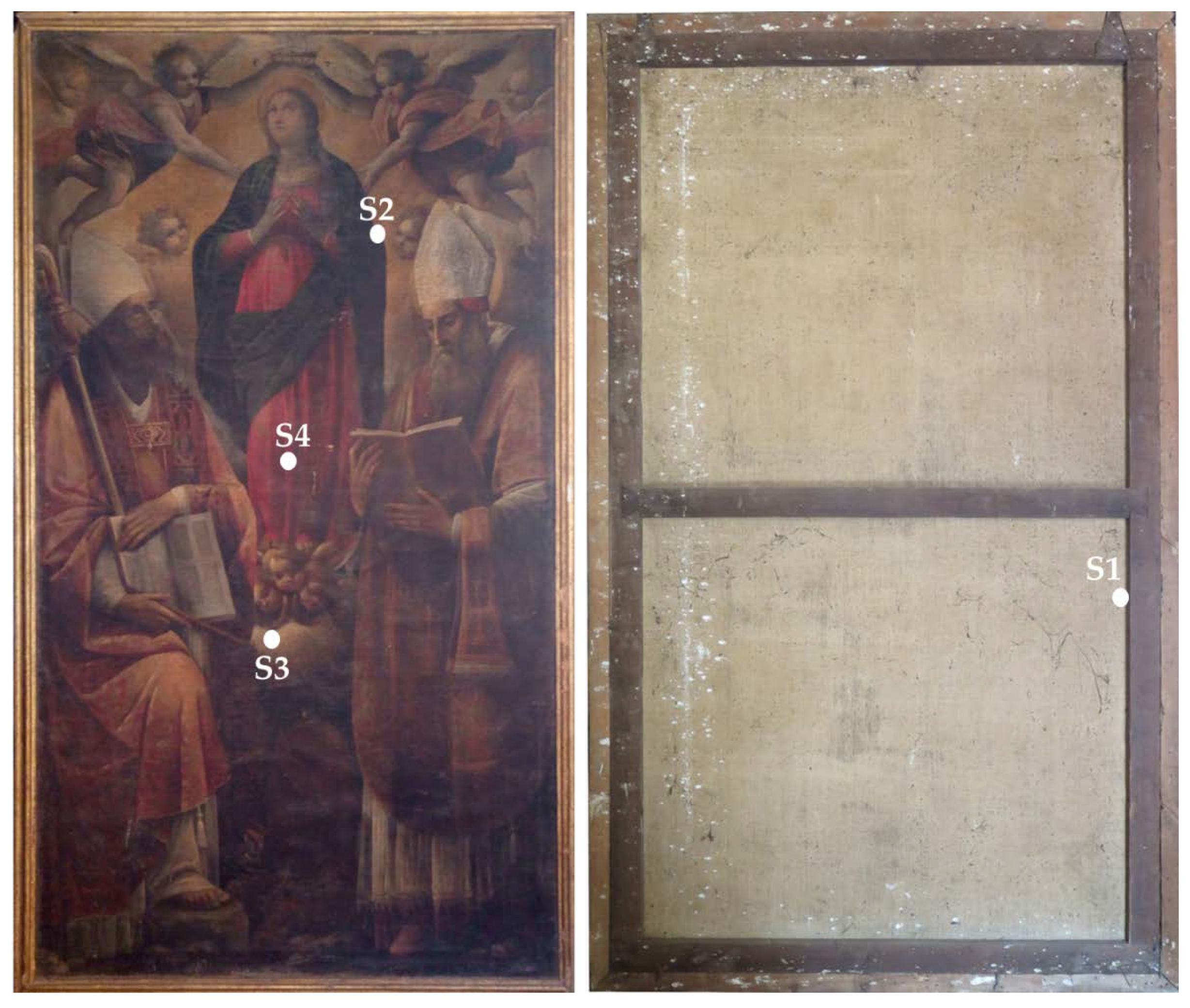
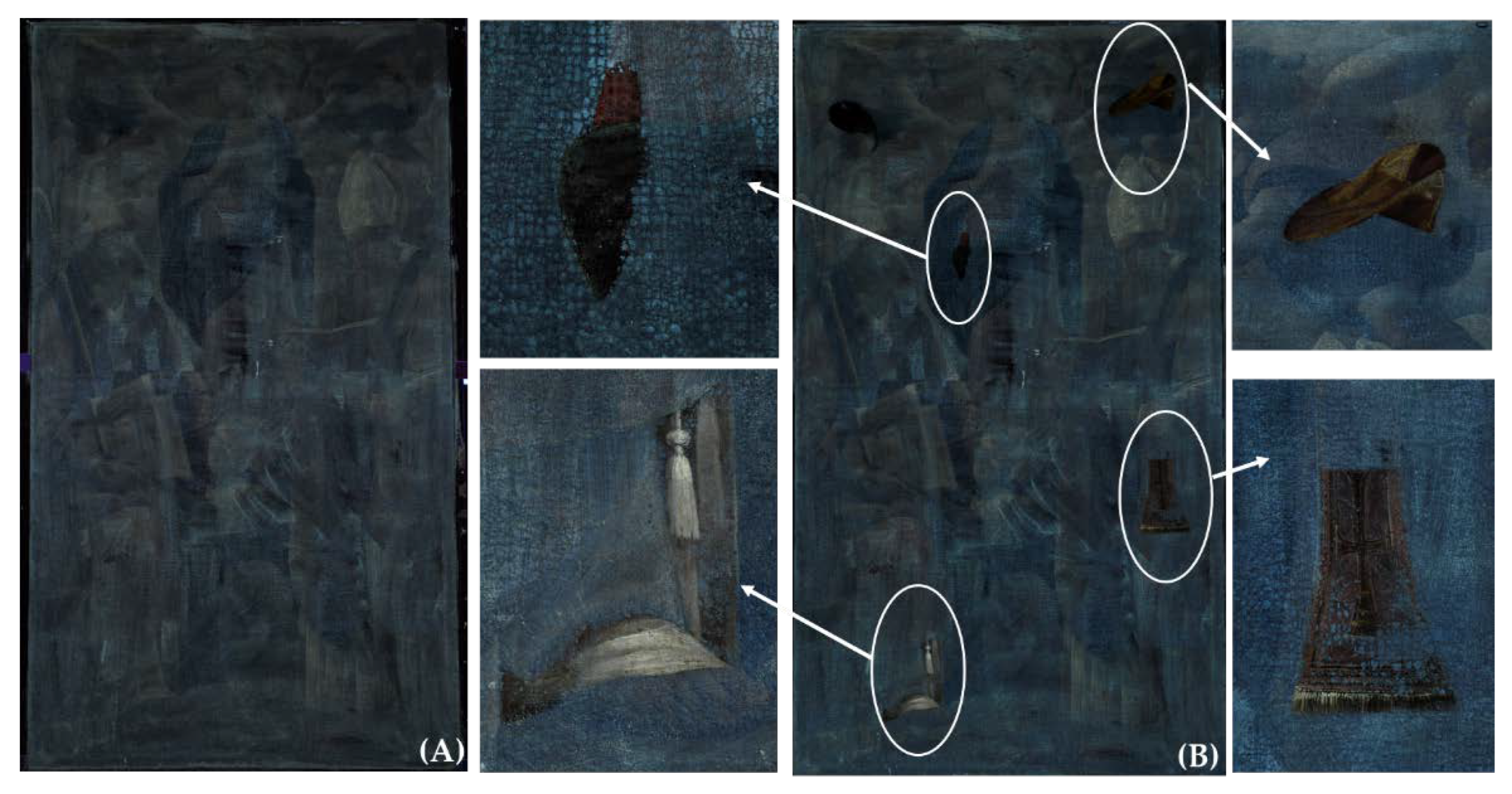

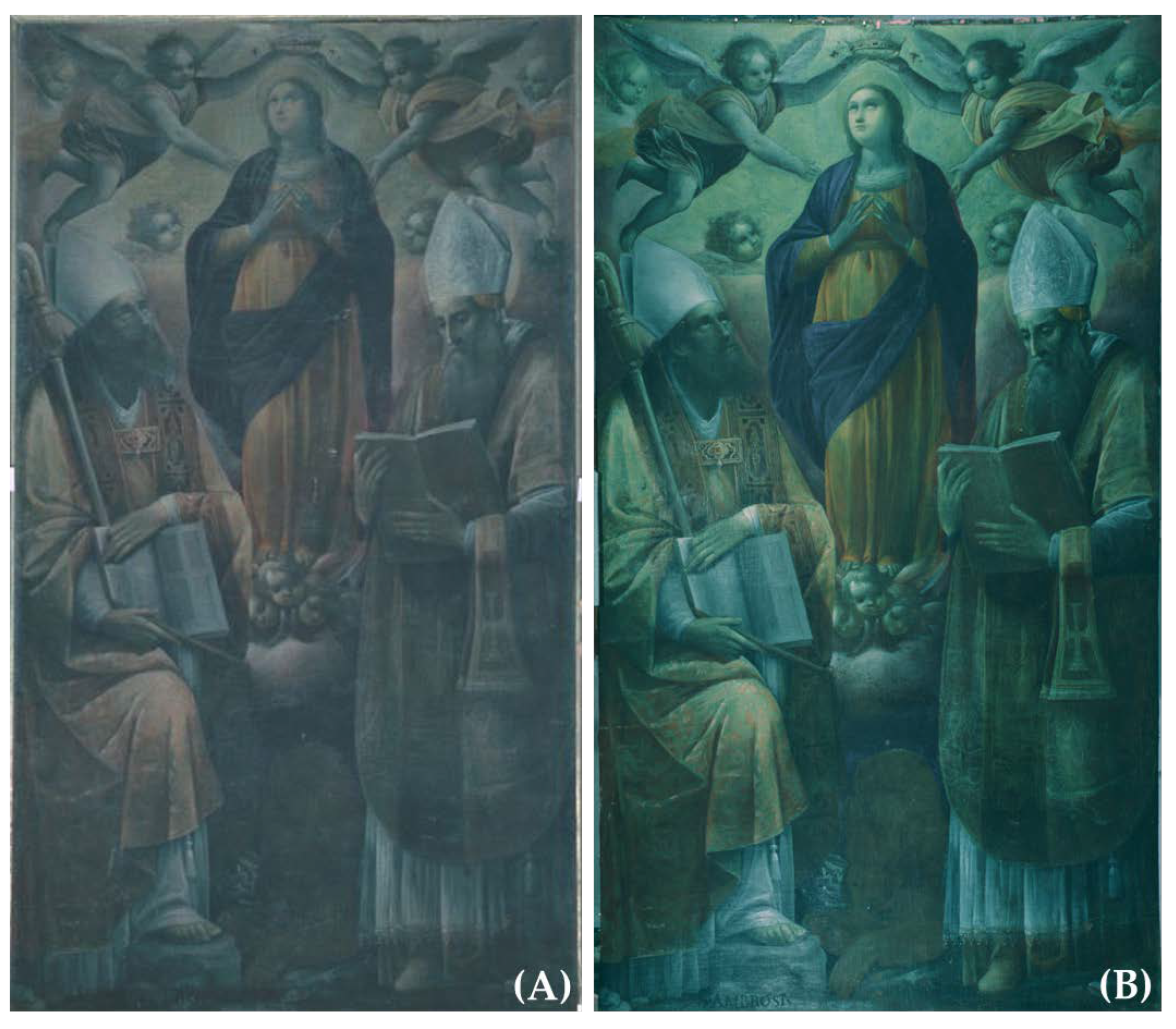
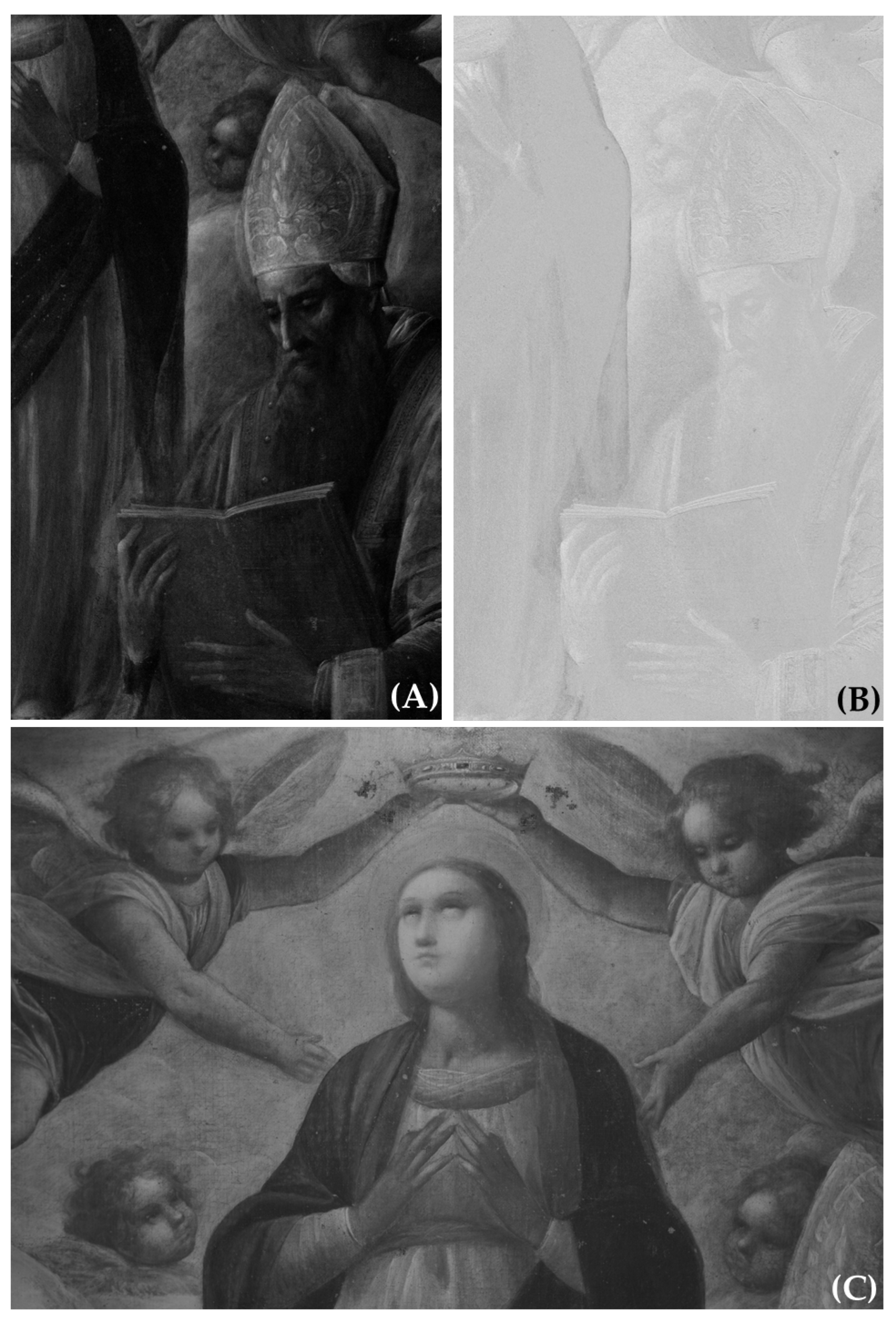

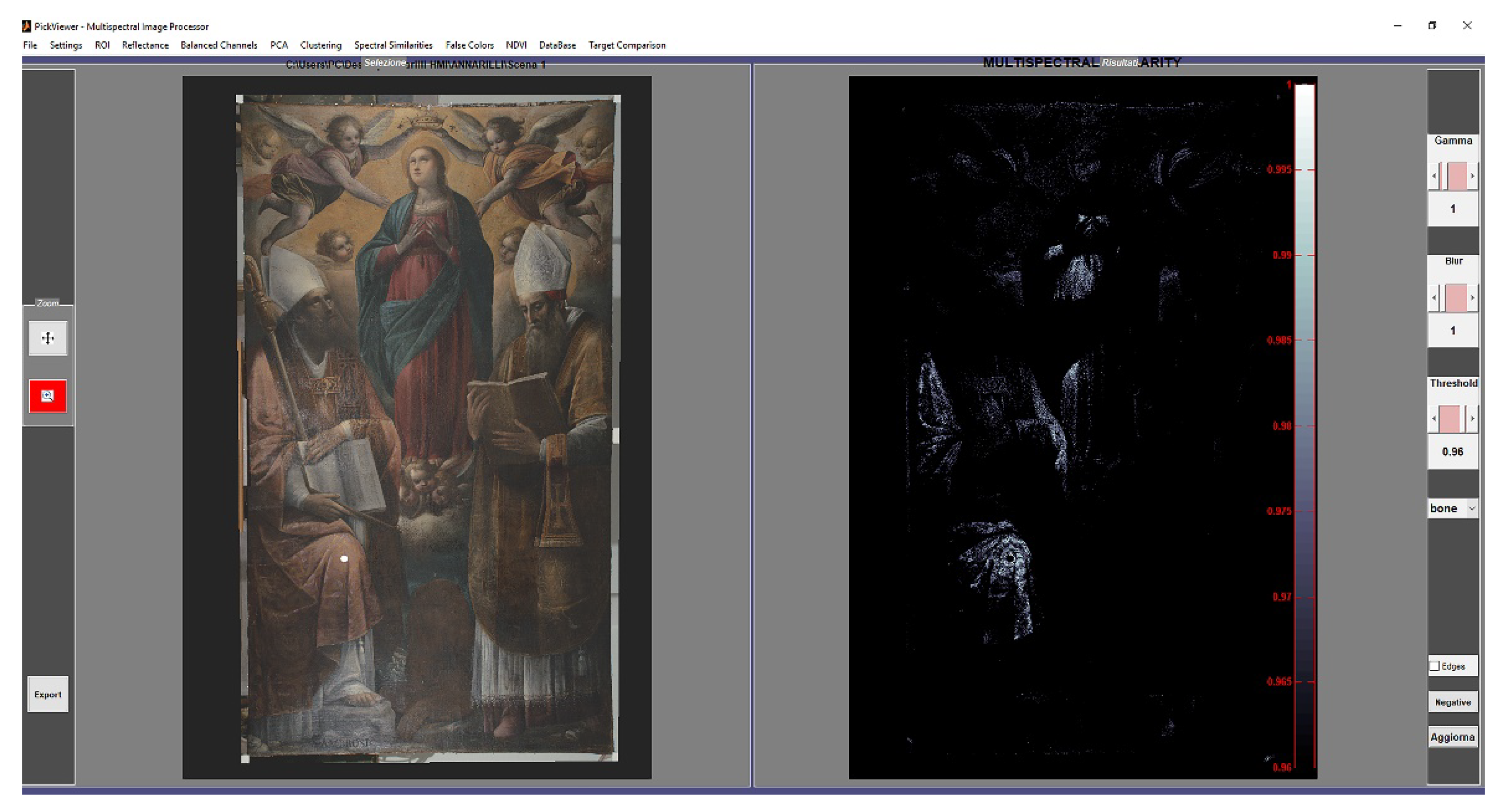


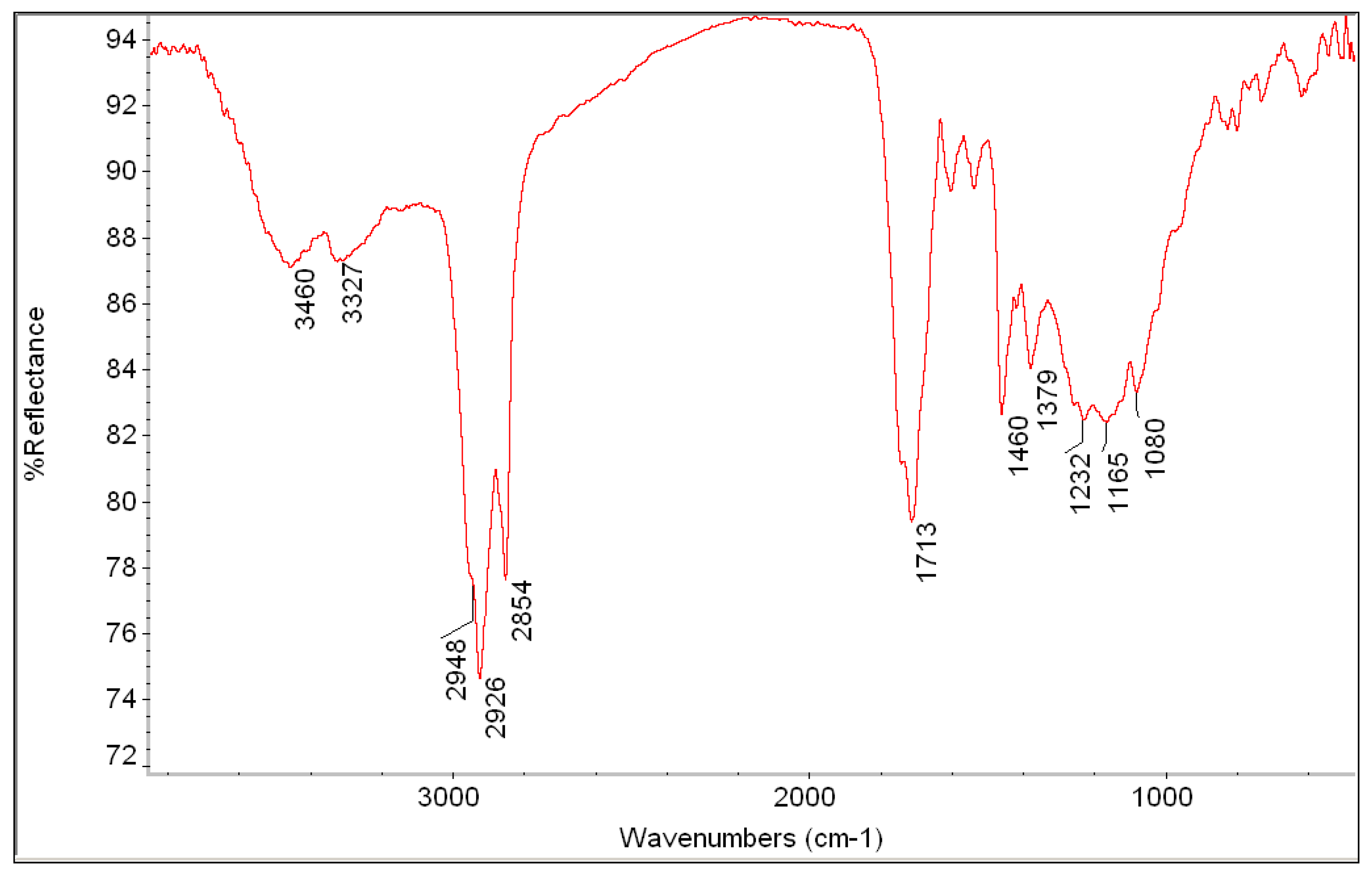
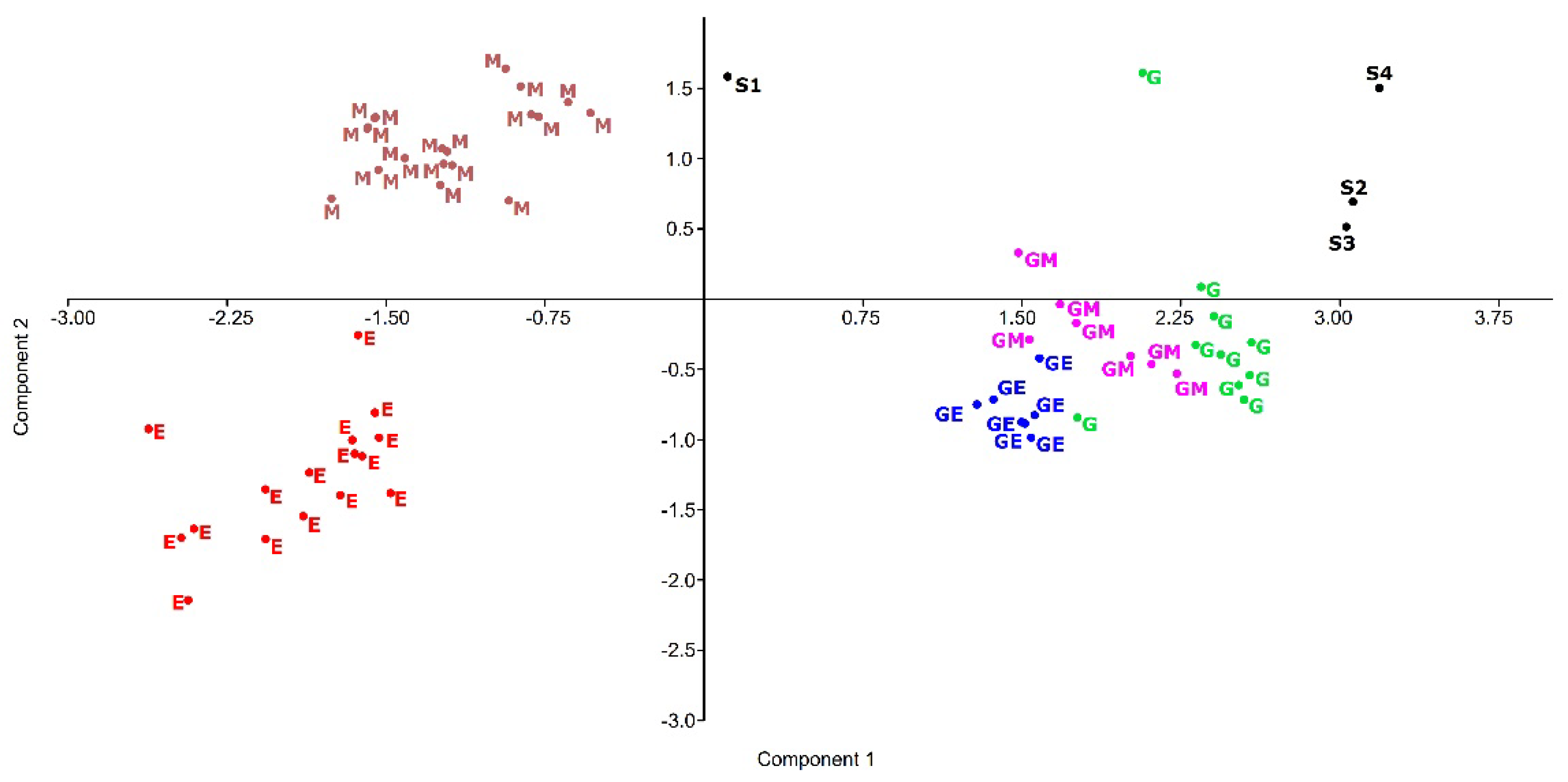
| Analysis Point | Color | Detected Elements | Proposed Pigments |
|---|---|---|---|
| P1—tassel of the dress of St. Ambrose | White | Pb, Fe | Lead white |
| P2—St. Ambrose dress | Yellow | Pb, Ca, Fe | Yellow ochre + possible lead oxide |
| P3—Jewel pendant of St. Ambrose | Yellow | Pb, Fe, Ca | Yellow ochre + possible lead oxide |
| P4—Central square of the jewel of St. Ambrose | Red | Pb, Hg, Ca, Fe | Vermillion + red ochre |
| P5—Dress of the right angel | Green-Blue | Pb, Cu, Fe, Ca | Cu-based pigment + ochre |
| P6—Dress of the angel | Pink | Pb, Fe, Ca, Hg | Vermillion + red ochre |
| P7—Halo of the Virgin | Yellow | Pb, Fe, Ca | Yellow ochre + possible lead oxide |
| P8—Virgin’s dress | Red | Pb, Hg, Fe, Ca | Vermillion + red ochre |
| P9—Virgin dress | Light blue | Cu, Pb, Fe, Ca | Azurite + lead white |
| P10—Background near St. Ambrose | Dark | Cu, Pb, Ca, Fe | Cu-based pigments |
| P11—Pallium | Black | Cu, Fe, Hg, Pb, Ca | Copper-based pigment, vermilion |
| P12—Right angel | Yellow | Pb, Fe | Lead oxide and ochre |
| P13—Gilded frame | Gold | Ca, Au, Fe, Pb, Sr | Gold on ground layer |
| P14—Background between St: Ambrose and the Virgin | Light blue-grey | Cu, Pb, Fe, Ca | Copper-based pigment, lead white, ochre |
| P15—Mantle of the Virgin | Blue | Cu, Pb, Fe, Ca | Azurite, lead white, ochre |
| P16—Background near St. Ambrose’s tiara | Grey | Cu, Pb, Fe, Ca | Copper-based pigment, lead white, ochre |
| P17—Possible repainting near St. Jerome tiara | Black | Pb, Cu, Fe, Ca | Lead-based pigment, azurite, ochre |
| P18—Shadow of the handpiece of S. Jerome | Red-brown | Pb, Fe, Ca | Lead-based pigment, ochre |
| P19—Background of the landscape | Light blue | Cu, Pb, Fe, Co, Ca | Azurite, blue smalt, lead-white, ochre |
| P20—Background of the landscape | Light blue | Cu, Pb, Fe, Co, Ca | Azurite, blue smalt, lead-white, ochre |
| P21—Virgin’s mantle (pentimento) | Blue | Pb, Cu, Fe, Ca, Co | Azurite, blue smalt, lead-white, ochre |
| P22—Background near the Virgin’s mantle | Light blue-grey | Cu, Pb, Fe, Ca, Co | Azurite, blue smalt, lead-white, ochre |
| Material to be Removed | Bacterial Strain |
|---|---|
| Animal glue | Ochrobactrum sp. TSNRS15 |
| Pseudomonas stutzeri CONC 11 | |
| Pseudomonas stutzeri CONC 12 | |
| Mastic resin | Acinetobacter sp. CONC 8 |
| Acinetobacter calcoaceticus LAM 21 | |
| Acrhomobacter xylosoxidans CONC 18 |
Publisher’s Note: MDPI stays neutral with regard to jurisdictional claims in published maps and institutional affiliations. |
© 2022 by the authors. Licensee MDPI, Basel, Switzerland. This article is an open access article distributed under the terms and conditions of the Creative Commons Attribution (CC BY) license (https://creativecommons.org/licenses/by/4.0/).
Share and Cite
Annarilli, S.; Casoli, A.; Colantonio, C.; Lanteri, L.; Marseglia, A.; Pelosi, C.; Sottile, S. A Multi-Instrument Analysis of the Late 16th Canvas Painting, “Coronation of the Virgin with the Saints Ambrose and Jerome”, Attributed to the Tuscany-Umbria Area to Support the Possibility of Bio-Cleaning Using a Bacteria-Based System. Heritage 2022, 5, 2904-2921. https://doi.org/10.3390/heritage5040150
Annarilli S, Casoli A, Colantonio C, Lanteri L, Marseglia A, Pelosi C, Sottile S. A Multi-Instrument Analysis of the Late 16th Canvas Painting, “Coronation of the Virgin with the Saints Ambrose and Jerome”, Attributed to the Tuscany-Umbria Area to Support the Possibility of Bio-Cleaning Using a Bacteria-Based System. Heritage. 2022; 5(4):2904-2921. https://doi.org/10.3390/heritage5040150
Chicago/Turabian StyleAnnarilli, Sofia, Antonella Casoli, Claudia Colantonio, Luca Lanteri, Angela Marseglia, Claudia Pelosi, and Sabrina Sottile. 2022. "A Multi-Instrument Analysis of the Late 16th Canvas Painting, “Coronation of the Virgin with the Saints Ambrose and Jerome”, Attributed to the Tuscany-Umbria Area to Support the Possibility of Bio-Cleaning Using a Bacteria-Based System" Heritage 5, no. 4: 2904-2921. https://doi.org/10.3390/heritage5040150
APA StyleAnnarilli, S., Casoli, A., Colantonio, C., Lanteri, L., Marseglia, A., Pelosi, C., & Sottile, S. (2022). A Multi-Instrument Analysis of the Late 16th Canvas Painting, “Coronation of the Virgin with the Saints Ambrose and Jerome”, Attributed to the Tuscany-Umbria Area to Support the Possibility of Bio-Cleaning Using a Bacteria-Based System. Heritage, 5(4), 2904-2921. https://doi.org/10.3390/heritage5040150















